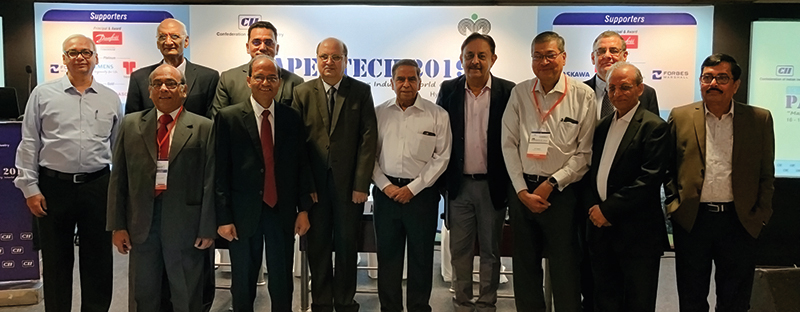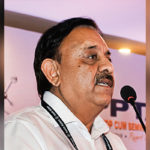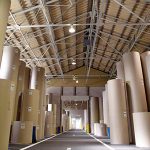Aimed at making Indian Pulp and Paper Industry world class, the 13th edition of PaperTech 2019, jointly held by Confederation of Indian Industry (CII) and Indian Paper Manufacturers Association (IPMA) during September 16-18 at Hyderabad, got off to a flying start with thought-provoking addresses from some of the industry’s bigwigs.

In his welcome address, Ganesh Bhadti, Vice Chairman, PaperTech 2019 and Vice President, Technical SPB Limited, said that main objectives of PaperTech 2019 were to facilitate continual improvement in the performance of the pulp and paper industry in India and to give plant managers and engineers an opportunity to find innovative ways to face their day-to-day challenges. PaperTech 2019 would focus on on latest innovations, energy efficiency, waste and water management and sustainability, he added. He said that energy and water were the main focus areas of the industry and that PaperTech 2019 would address those issues in full measure. He hoped that the conference would bring healthy discussions, debates and meaningful outcomes.


| Ganesh Bhadti, Vice Chairman, PaperTech 2019 and Vice President, Technical SPB Limited | Sanjay Singh, Chairman, PaperTech 2019, President, IPPTA, and Divisional Chief Executive, ITC Limited PSPD |
Speaking at the conference, Sanjay Singh, Chairman, PaperTech 2019, President, IPPTA, and Divisional Chief Executive, ITC Limited PSPD, said that the pulp and paper industry in India not only presented challenges but also opened up several opportunities for further growth. The recent announcement by the Prime Minister about the abolition of single-use plastic had created a wonderful opportunity for the paper industry to produce a perfectly acceptable paper substitute for some of the single-use plastic, he added. “We cannot compare paper with plastic because some of the properties of paper do not match with those of plastic and the cost of plastic differs from that of paper. But in the last few years, there has been a huge development in the area of substitution of plastic with paper. For example, plastic straws are now being replaced with paper straws. The paper industry must take full advantage of this trend. We have to find innovative ways of substituting plastic with paper; and we need to find the right technology to fulfill this task. The industry must also focus on cost-reduction. The cost of packaging and paper is rather high the world over – especially in India. CII and PaperTech must work together to bring down the cost of paper so that more and more people use paper and paper products and we as an industry become relevant to the economy. The paper industry in India is small in size, but it has enormous potential for growth. We must work together to unlock this potential,” he said.

Director and CEO, Emami Paper Mills
Speaking on the occasion, P. S. Patwari, President, INMA and Executive Director and CEO, Emami Paper Mills, said that the total consumption of newsprint in India was 2.5 MT/annum , out of which only 1MT/annum was produced indigenously; the rest of it, that is, 1.5 MT/annum, was imported. He said, “We can easily produce the 1.5 MT of newsprint which is being imported and save precious Forex every year and simultaneously generate employment opportunities for lakhs of people directly or indirectly.
“For the last so many years, we have been trying to convince the government to provide us with a level-playing field so that we could contribute towards the growth of the print medium – the size of which is more than 20,000 crore per annum and the growth rate of which is 10 to 12 percent per annum. To get a level-playing field, anti-dumping measures are required. Dumping takes place in our country in a big way. India is the fastest growing market in the world for paper, but inadequate availability of raw materials has taken its toll on the growth of the industry. In addition, the government’s policy of extending preferential tariff treatment to import of paper under the free trade agreements (FTAs) has left the industry exposed to cheaper imports hurting domestic manufacturing. We have requested Hon’ble Piyush Goel, Minister of Railways and Minister of Commerce & Industry in the Government of India, to look into the matter. He has assured us that due care will be taken to safeguard the interest of the domestic industry.”
In his special address, Pramod Agarwal, President, IARPMA and Chief Managing Director, Rama Paper Mills Limited, said, “The paper industry is an important industry. The literacy rate of a society is measured in terms of consumption of paper. Paper mills in India are creating wealth. A majority of the mills in India are based on non-conventional raw materials like agricultural residues and waste paper. Besides, wood-based paper mills meet their raw material requirements through agro forestry or social farming. Paper industry is also involved in Swachh Bharat Abhiyan initiated by our Prime Minster. Unfortunately, the paper industry in India has grown in clusters and is largely localized. This has put some pressure on plans for expansion of paper mills. The situation has worsened due to the fact that there is always a question mark on the availability of fiber. Despite these challenges the industry can rise and shine, chase new horizons.”


| Pramod Agarwal, President, IARPMA and Chief Managing Director, Rama Paper Mills Limited | A. S. Mehta, President, IPMA, and President and Director, JK Paper Limited |
Addressing the gathering, A. S. Mehta, President, IPMA, and President and Director, JK Paper Limited, said, “The Indian paper market is the brightest spot on the global paper market. It is growing at a healthy rate, at around 6 to 7 percent per year. This means that the Indian paper market is not a small market. On the contrary, one finds many players on this market. The presence of several players makes the market highly competitive; and to compete on this market, we need to be world class. We need to be world class in terms of product quality, product cost, processes for paper production and the kind raw materials we have. We need to be more efficient in using, generating and collecting our raw materials so that we achieve the lowest cost as far as raw materials are concerned. We need to be competitive on the cost of raw materials. Agro-based and recycle-based mills need to have an efficient collection system. The quality of the paper collected also has to be world class so that we get the right kind of material for recycling, which we can do only when we have virgin-quality material. In addition, our logistics cost has to be optimum. We also need to be competitive on energy and water. We need to reduce our consumption of fossil fuel and water. Of course, the industry has been able to reduce its energy and water consumption, but still a lot more needs to be done. In times to come, the water challenge will become bigger. So, we must learn to conserve and recycle water to the greatest extent. The cost of energy for the country is rather high. To reduce the cost of production and to remain competitive, we need to reduce our energy consumption. The use of automation and modern technology requires energy. If we do more automation, we consume more energy. And so, there will always be scarcity of fossil fuel. There is a conflict here. We need to work in such a way that our cost of production comes down and, at the same time, we consume less energy to produce more. We need to work on all these fronts collectively so that we remain competitive and become world class.”
“The availability of technical talent poses another challenge. We cannot survive unless we have the right kind of talent for the industry – younger technically talented people. We need to attract fresh talent to the industry. It’s difficult to attract young talented people because the paper industry is not a glamorous industry. Our manufacturing locations are not attractive – and that’s because they are far from main cities. So, what should we do to attract and retain talent? We need to provide young talented people with challenging opportunities and an atmosphere and ambience where they could enjoy doing their work. We need to compensate them adequately as well.
“We must also work collectively on collaborative innovation. But, unfortunately, we don’t have the right kind of research facilities in the country. Why can’t we have a world-class research institute in the country? We must collectively consider the need for having such an institute in India.”
Towards the end of the inaugural session, a manual titled, Best Practices Manual – Pulp & Paper (Volume 10), was released.



